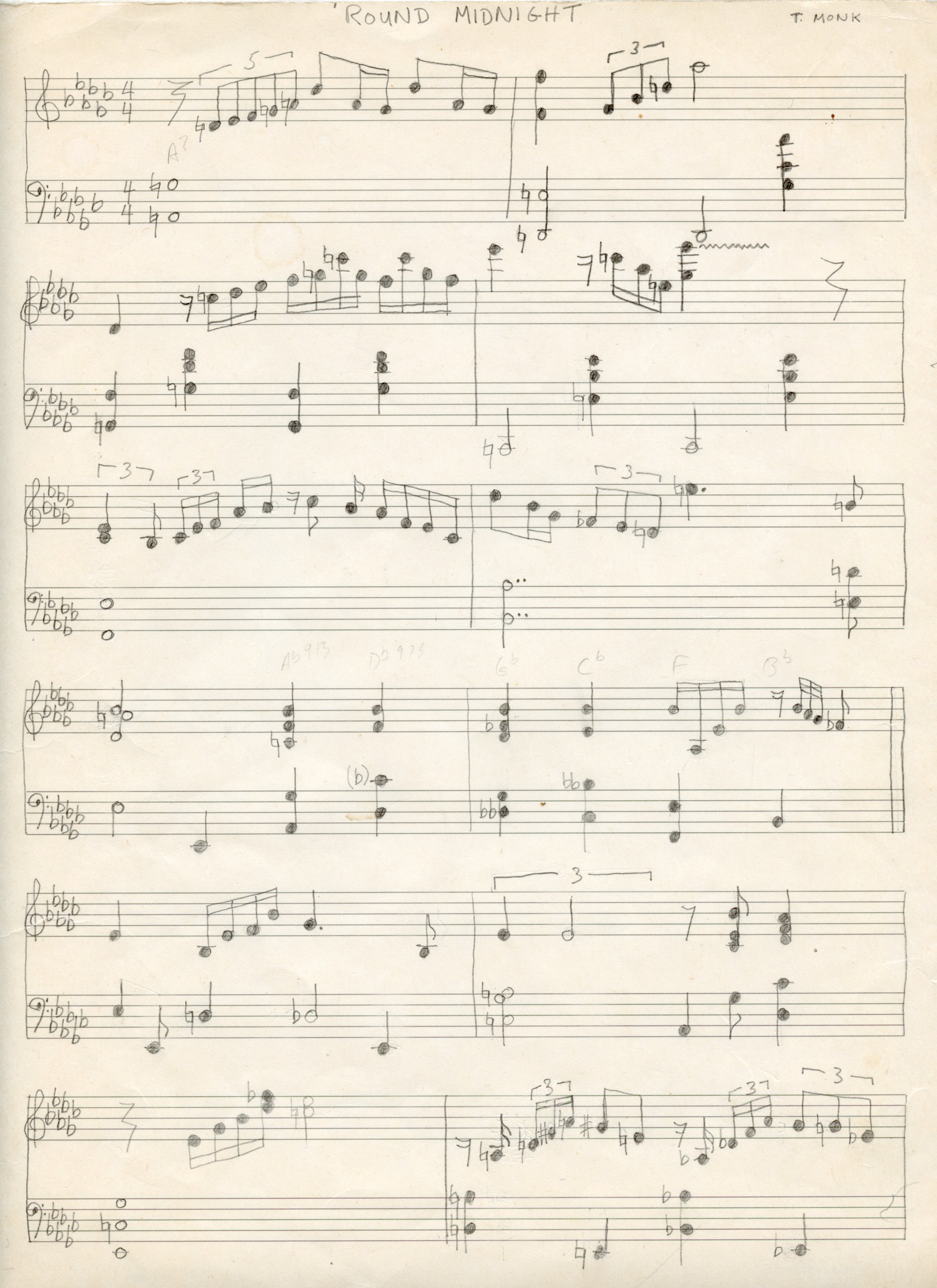’Round Midnight was one of the first songs I tuned into when beginning to listen to jazz piano in the mid-1970s. This transcription is based on Monk’s 19 November 1968 recording which I first heard in the Spring of 1976 on the two-fer collection, A Jazz Piano Anthology (front and back cover headlines the top of Music). Transcribed in 1989, it is one of the most harmonically rich works I ever put to paper (original copy below).
In the Spring of 2004, I studied music theory with Adam Larabee[ref][ref][ref] when he was teaching at New England Conservatory. On May 25th we worked through chord analysis of 3 pages: the introduction (p.1), the first verse (p.2), and the bridge (p.4). A partial transcript as well as primitive recording of this 30-minute session is presented below.
Long overdue, I filmed myself playing this in March 2024.
Two copies are included here: one with the chord progression and one without. The chord-less copy is for students to analyze for their own study.
With chords:
Round Midnight Chord Analysis
Jazz Theory Lesson with Adam Larabee, 25 May 2004
primitive audio recording of lesson (31:06)
(0:16)
DR: I don’t remember why I thought it was in the key of ... G flat Major.
(0:32)
AL: I think you chose that key signature because the song is in E flat minor. This is the key signature for G flat Major or E flat minor—they share the same key signature ...
(3:01)
Monk has intentional cluster voicings so how we analyze his chords and how we decide to term it for lead sheet purposes are slightly different.
Measure 2

(3:46)
[Monk is] purposely putting the crunch in that cluster sound, putting the natural E against the F natural. So it’s not really a D natural 9 but it is a D natural 9. It is some sort of D dominant 7th but it has these alterations on it, it has the sharp 9 ...
(4:35)
maybe sharp 9 and the natural 9, and that’s very Monk. You don’t really see that but that might be the right way to notate it....
(4:58)
Maybe D7 flat 5 might be our default chord (for the whole measure), because that way if I were to play guitar chords behind you, I’d leave out the 9th and leave all this Monk’isms to you.
Measure 1
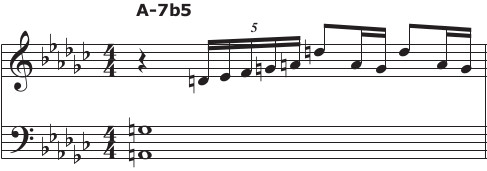
(5:14)
DR: And this for A, it’s some kind of A7.... Minor because it’s going to the D7.
AL: Context—and also the flat 5 [E flat: 2nd note in r.h.] and the emphasis on the natural 11, you will predominantly see on minor chords because the natural 11th is an avoid note for chords that have a major third. If this were in an A Major chord, you call D natural an avoid note because of the texture. But on minor, D sits next to C natural. That’s just the intervallic dissonance [C# up to D] of the minor 9th. Ironically Monk loves that sound and uses it quite a bit. But in terms of our vertical [chord] structures, this is very dissonant.
[It’s a flat 5 and it’s a II-V sequence.]
(7:30)
They’re minor II-Vs [M1-2, M3-4]. This one wants to go to G minor. This is a minor II and it’s dominant, and you go to G minor but that’s another sequence.
DR: But why does it want to go to G minor rather than G Major?
AL: Because it has a [II] minor 7 flat 5. Remember? We talked about this a while ago: if it’s a minor seventh chord in the context of a II-V and it has a natural fifth, it is leading you to believe that it will go to an A Major chord because this II comes from G Major.
[If the II is a minor seventh flat five you think it’s going to resolve to a minor because].
(8:02)
It’s going to do this [playing]:
A-C-E-G [II-7] →
A-C-E-F# [V7] →
G-B-D-F# [IM7].
This [playing],
A-C-Eb-G,
is the II chord for G minor:
A-C-Eb-G [II-7b5] →
A-C-Eb-Gb [V7b9] →
G-Bb-D-F [I-7]
or
G-Bb-D-F# [G-M7].
But of course you could go either way:
II-7→V9→I-7 to minor,
or
II-7b5→Vb9→IM7 can go to Major.
But this is a sequence: II(M1)→V(M2)→I(M3)? No, sort of; II-V, II-V, II-V.
Measure 5

(8:45)
AL: And this very, very close [I had marked F-7] but remember, the key signature has C flat in it.
DR: So it’s flat 5?
AL: It’s the same thing, it’s a sequence.
Measure 7 beat 1
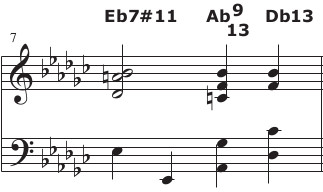
(The A natural is a #11 because it’s right against the fifth.)
(10:55)
AL:
These are cycle of fifths again. This is technically I because it’s been led to by the B flat. So there’s your seventh, V-I. So this is II-V (M1-2), II-V (M3-4), II-V (M5-6), I. You’re going to see this a lot. Three sequences; very, very common.
Measure 8 beat 2
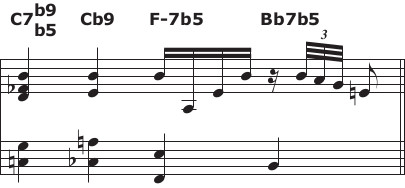
(11:44)
DR: Maybe it’s not a D double-flat, maybe it’s a C natural....
(12:59)
AL: That’s a Monkism. If that is indeed correct, I’d have to hear the recording—there’s a major 7th and a dominant 7th against it. If this is correct, I would say it’s a C flat dominant 7th or a C flat 9 chord. And the fact that the major 7th works is because there’s a pedal point. He’s kept the B flat on top all the way through. So here it is theoretically incorrect because a major 7th and a dominant 7th cannot coexist so it’s a cluster. It’s an intentional wrong note. But it has been justified by a pedal point. So as you repeat notes in the melody or the base you can get away with more and more dissonance because the ear has become accustomed to it, having been repeated.
M8 b3
(14:21)
AL: And this I’m going to make a minor 7 flat 5 because if there were to be a fifth in it, it would be C flat because of the key and also because of the chord before it. So even though there’s no C flat in here [the 3rd beat], I think it would be a minor 7 flat 5 because it is going to E flat minor (M9) and the II chord of E flat minor is always going to be a minor 7 flat 5. The II chord in a minor II-V is always minor 7 flat 5....
(15:17)
Because this is setting up our A section and that this (M9) is an E flat minor chord and to put in context, this [E flat minor] is our key, this is the II chord of E flat minor, and the II chord of any minor, the true II chord, the II chord that is created because it is using all notes from the minor key, will be a minor 7 flat 5. And the same thing is happening here [in M1, M3, and M5]: all these minor 7 flat 5s are assuming that the cadence is going to a minor—whether it goes there or not.
M8 b4
(15:55)
AL: And this is a B flat dominant 7th even though there is no 3rd here, it is the V of that [M8 b3] in context. So Monk isn’t leaving out crucial notes but the omission is OK because of the context. We’re hearing what’s not being played. And I would probably put a flat 5 because of the accidental on the E natural (B flat - A flat - G flat - E natural). Those little fragments of whole tone scales are very Monk as well.
Measure 9
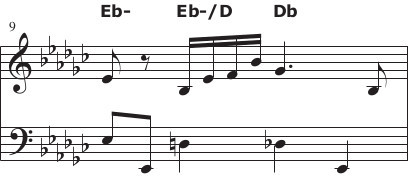
(16:36)
AL: Then we skip to here, E flat minor.
It’s an E flat minor measure with different notes in the bass—there’s a new melody in the base. This is so classic, and in so many songs....
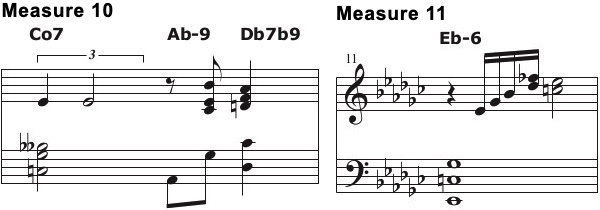
(18:49)
AL: Here’s a II-V. This is interesting. It’s a II-V [in M10 b3-4] that you’d think would go to G flat Major which is the relative major of E flat minor. But instead it goes back to E flat minor. And it’s a good example of two things: one is of a deceptive cadence because you think D flat is going to go to G flat but it goes up to E flat, and also an example of what we had talked about before as a back door cadence, by going up a whole step.
Measure 12 beat 1
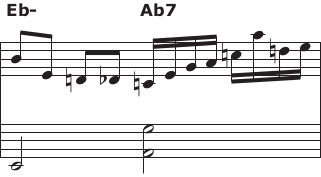
(19:32)
AL: This is, I would say B-7 to E7 and Bb-7 to Eb7 and this is a sequence. And even though there are not dominance here, the context serves....
(22:11)
And this is not a progression; E flat (M11) to B minor (M12) is not a progression. What’s happening is here you’re in E flat, which is the key and this is a II-V to IV (M12 b3-4 to M13) and this is just a II-V (M12 b1-2) a half step above.
Measure 14 beat 1
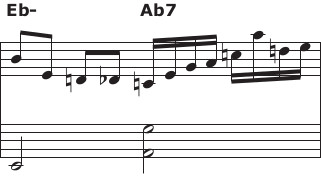
(22:47)
AL: Monk very often played this as a G flat Major 7....
DR: Is it a major or a minor E flat?
AL: It’s minor.
DR: Because of the key, because it’s relative.
AL: Yes. And it’s the only one that you can really make that assumption....
DR: Have you seen this scored as an E flat minor key signature?
AL: Yes.
Measure 16
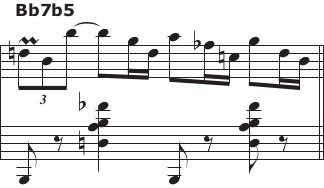
(24:15)
The whole melodic information here in measure 16 is a whole tone scale.
